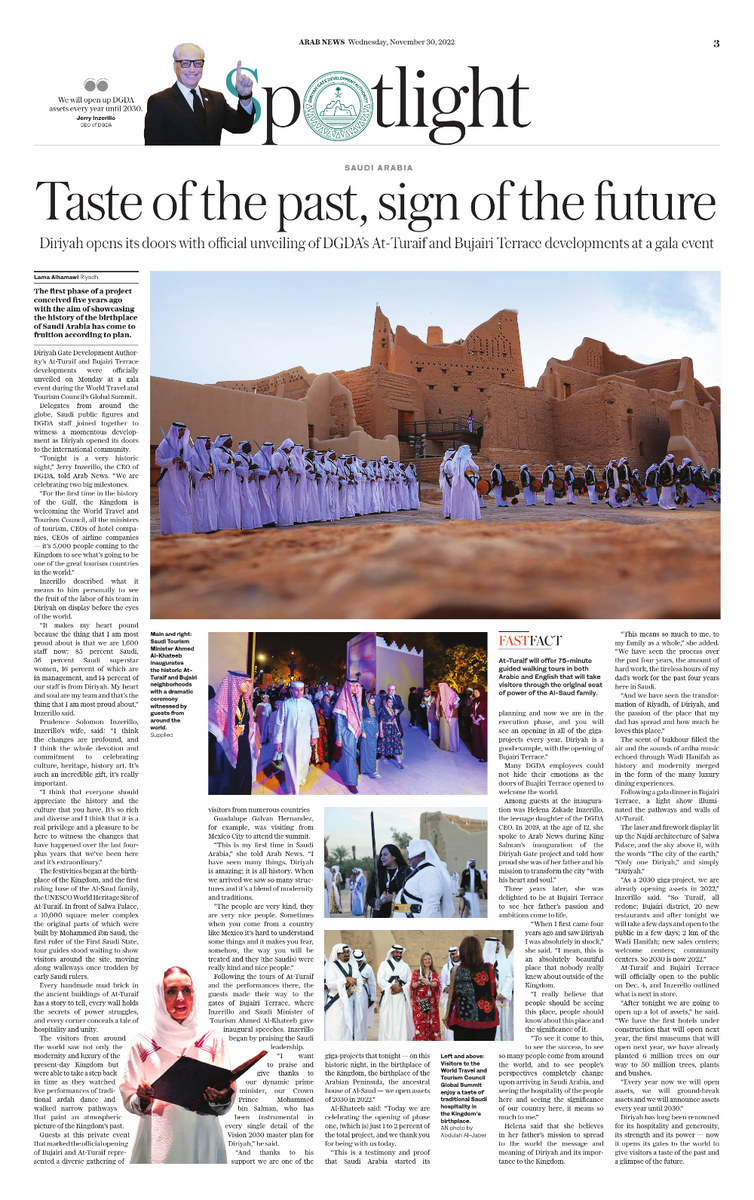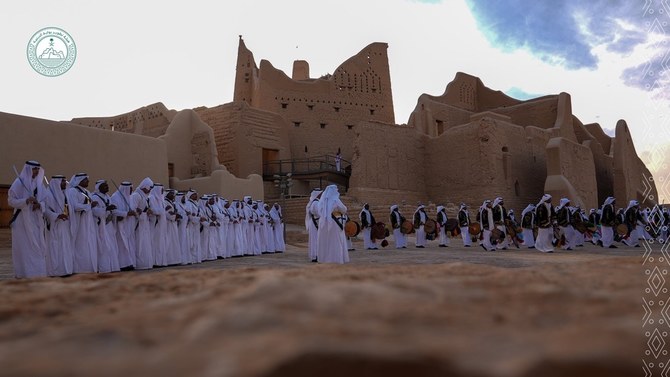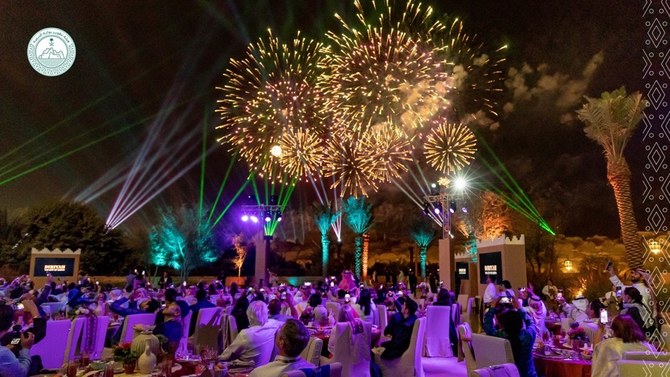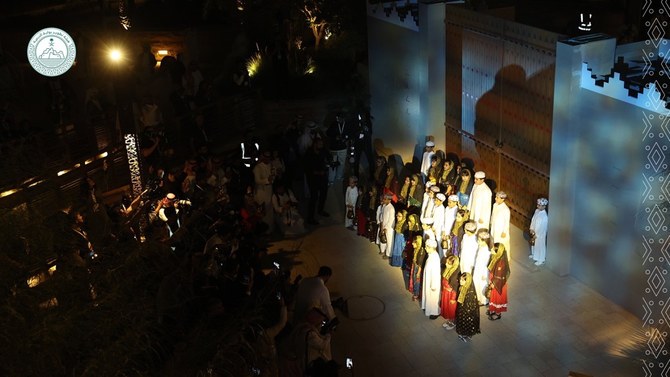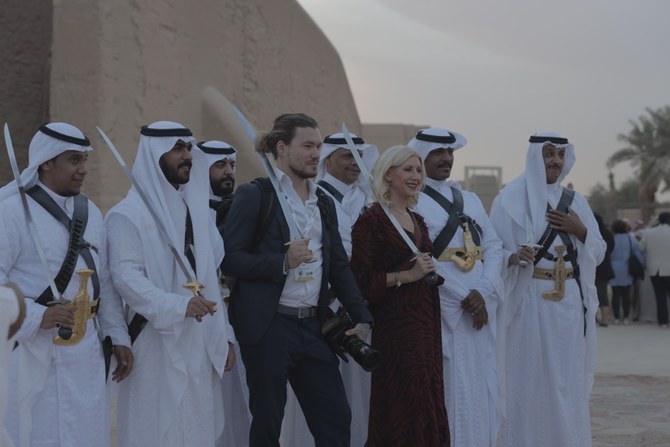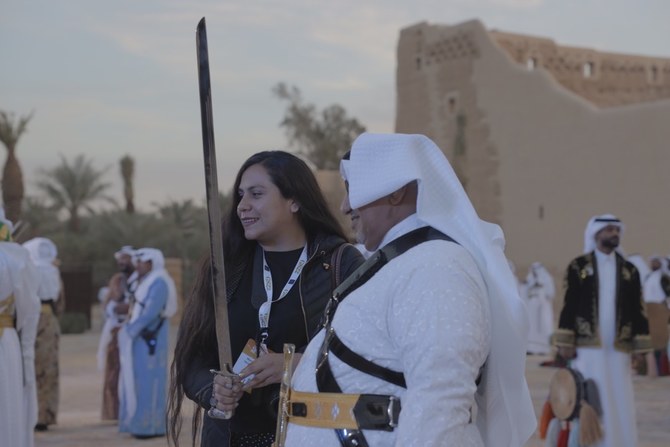RIYADH: The first phase of an aspirational project conceived five years ago, with the aim of showcasing the history of the birthplace of the Kingdom of Saudi Arabia, has come to fruition according to plan.
Diriyah Gate Development Authority’s At-Turaif and Bujairi Terrace developments were officially unveiled on Monday at a gala event during the World Travel and Tourism Council’s Global Summit.
Delegates from around the globe, Saudi public figures and DGDA staff joined together to witness a momentous development as Diriyah opened its doors to the international community.
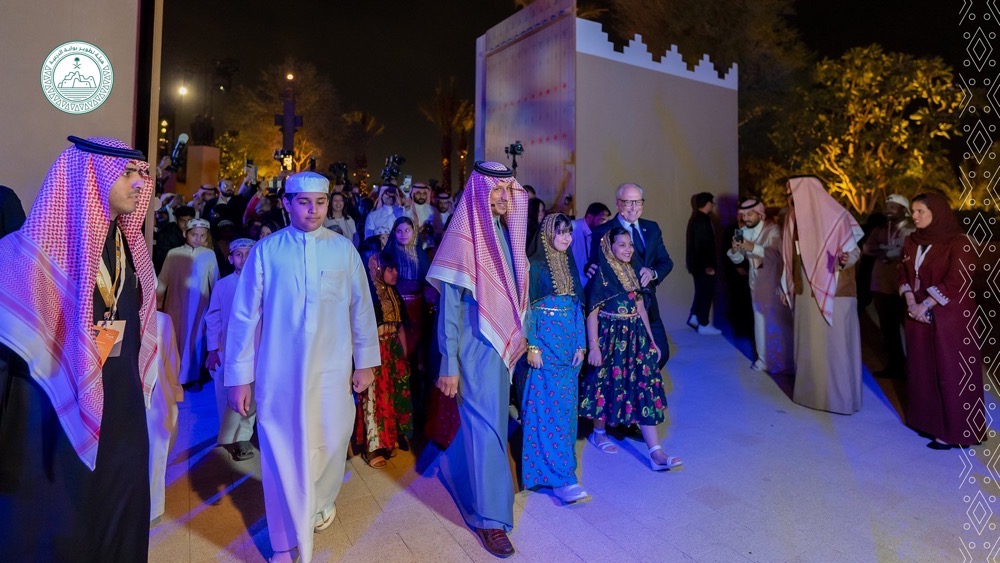
Saudi Tourism Minister Ahmed Al-Khateeb inaugurates the historic At- Turaif and Bujairi neighborhoods with a dramatic ceremony witnessed by guests from around the world. (DGDA)
“Tonight is a very historic night,” Jerry Inzerillo, the CEO of DGDA, told Arab News. “We are celebrating two big milestones.
“For the first time in the history of the Gulf, the Kingdom is welcoming the World Travel and Tourism Council, all the ministers of tourism, CEOs of hotel companies, CEOs of airline companies — it’s 5,000 people coming to the Kingdom to see what’s going to be one of the great tourism countries in the world.”
Inzerillo described what it means to him, personally, to see the fruit of the labor of his team in Diriyah on display before the eyes of the world.
“It makes my heart pound because the thing that I am most proud about is that we are 1,600 staff now: 85 percent Saudi, 36 percent Saudi superstar women, 16 percent of which are in management, and 14 percent of our staff is from Diriyah. My heart and soul are my team and that’s the thing that I am most proud about,” Inzerillo said.
Prudence Solomon Inzerillo, Inzerillo’s wife, said: “I think the changes are profound and I think the whole devotion and commitment to celebrating culture, heritage, history art … I think it’s such an incredible gift, it’s really important.
“I think that everyone should appreciate the history and the culture that you have. It’s so rich and diverse and I think that it is a real privilege and a pleasure to be here to witness the changes that have happened over the last four-plus years that we’ve been here and it’s extraordinary.”
The festivities began at the birthplace of the Kingdom, and the first ruling base of the Al-Saud family, the UNESCO World Heritage site of At-Turaif. In front of Salwa Palace, a 10,000 square meter complex the original parts of which were built by Mohammed ibn Saud, the first ruler of the First Saudi State, tour guides stood waiting to show visitors around the site, moving along walkways once trodden by early Saudi rulers.
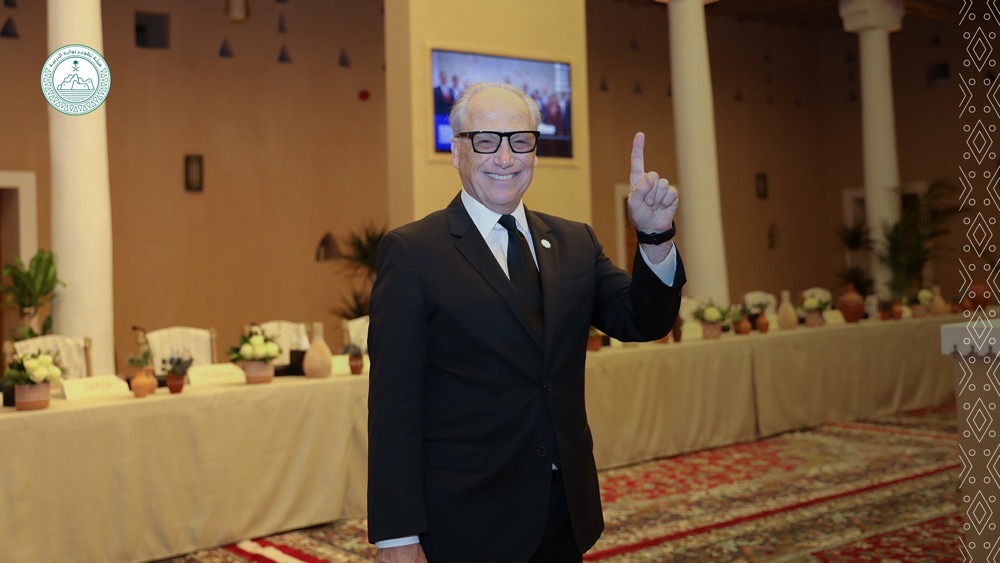
“Tonight is a very historic night,” Jerry Inzerillo, the CEO of DGDA, told Arab News. (DGDA)
Every handmade mud brick in the ancient buildings of At-Turaif has a story to tell, every wall holds the secrets of power struggles, and every corner conceals a tale of hospitality and unity.
The visitors from around the world saw not only the modernity and luxury of the present-day Kingdom but were able to take a step back in time as they watched live performances of traditional ardah dance and walked narrow pathways that paint an atmospheric picture of the Kingdom’s past.
The guests at this private event that marked the official opening of Bujairi and At-Turaif represented a diverse assemblage of visitors from numerous countries
Guadalupe Galvan Hernandez, for example, was visiting from Mexico City to attend the World Travel and Tourism Council summit.
“This is my first time in Saudi Arabia,” she told Arab News. “I have seen many things. Diriyah is amazing; it is all history. When we arrived we saw so many structures and it’s a blend of modernity and traditions.
FASTFACTS
• At-Turaif and Bujairi Terrace will open their doors to the public on Dec. 4.
• The Global Summit of the World Travel and Tourism Council is taking place for the first time in Saudi Arabia.
• At-Turaif will offer 75-minute guided walking tours in both Arabic and English that will take visitors through the original seal of power of the Al-Saudi family.
“The people are very kind, they are very nice people. Sometimes when you come from a country like Mexico it’s hard to understand some things and it makes you fear, somehow, the way you will be treated and they (the Saudis) were really, really kind and nice people.”
Following the tours of At-Turaif and the performances there, the guests made their way to the gates of Bujairi Terrace, where Inzerillo and Saudi Minister of Tourism Ahmed Al-Khateeb gave inaugural speeches. Inzerillo began by praising the Saudi leadership.
“I want to praise and give thanks to our dynamic prime minister, our Crown Prince Mohammed bin Salman, who has been instrumental in every single detail of the Vision 2030 master plan for Diriyah,” he said.
“And thanks to his support we are one of the giga projects that tonight — on this historic night, in the birthplace of the Kingdom, the birthplace of the Arabian Peninsula, the ancestral house of Al-Saud — we open assets of 2030 in 2022.”
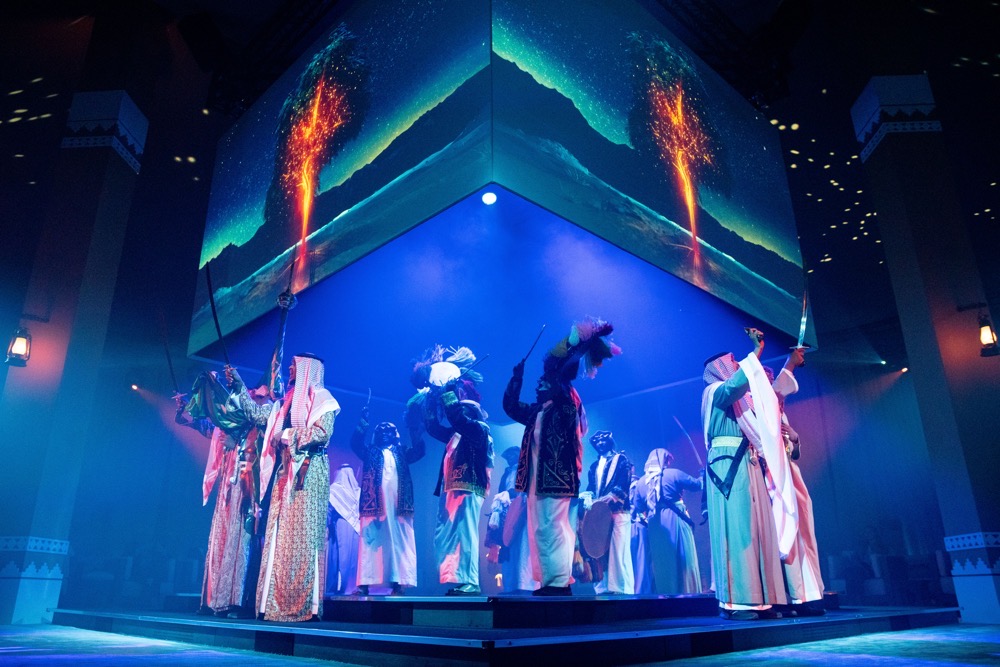
Diriyah Gate Development Authority’s At-Turaif and Bujairi Terrace developments were officially unveiled on Monday. (DGDA)
Al-Khateeb said: “Today we are celebrating the opening of phase one, (which is) just 1 to 2 percent of the total project, and we thank you for being with us today.
“This is a testimony and proof that Saudi Arabia started its planning and now we are in the execution phase and you will see an opening in all of the giga projects every year. Diriyah is a good example, with the opening of Bujairi Terrace.”
Many DGDA employees could not hide their emotions as the doors of Buajiri Terrace opened to welcome the world.
Among the guests at the inauguration was Helena Zakade Inzerillo, the teenage daughter of the DGDA CEO. In 2019, at the age of 12, she spoke to Arab News during King Salman’s inauguration of the Diriyah Gate project and told how proud she was of her father and his mission to transform the city “with his heart and soul.”
Three years later, she was delighted to be at Bujairi Terrace to see her father’s passion and ambitions come to life.
“When I first came four years ago and saw Diriyah I was absolutely in shock,” she said. “I mean, this is an absolutely beautiful place that nobody really knew about outside of the Kingdom.
“I really believe that people should be seeing this place, people should know about this place and the significance of it.
“To see it come to this, to see the success, to see so many people come from around the world, and to see people’s perspectives completely change upon arriving in Saudi Arabia, and seeing the hospitality of the people here and seeing the significance of our country here, it means so much to me.”
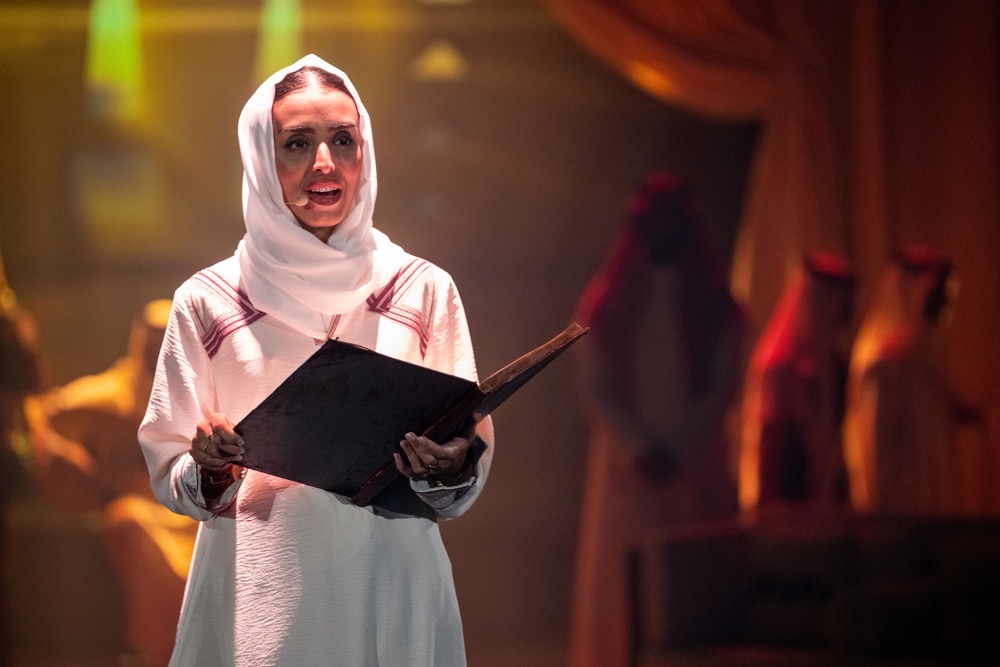
Diriyah has long been renowned for its hospitality and generosity, its strength and its power — now it opens its gates to the world. (DGDA)
Helena said she truly believes in her father’s mission to spread to the world the message and meaning of Diriyah and its importance to the Kingdom.
“This means so much to me, to my family as a whole,” she added. “We have seen the process over the past four years, the amount of hard work, the tireless hours of my dad’s work for the past four years here in Saudi.
“And we have seen the transformation of Riyadh, of Diriyah, and the passion of the place that my dad has spread and how much he loves this place.”
The scent of bukhour filled the air and the sounds of ardha music echoed through Wadi Hanifah as history and modernity merged in the form of the many luxury dining experiences. Following a gala dinner in Bujairi Terrace, a light show illuminated the pathways and walls of At-Turaif.
The laser and firework display lit up the Najdi architecture of Salwa Palace, and the sky above it, with the words “The city of the earth,” “Only one Diriyah,” and simply “Diriyah.”
“As a 2030 giga project, we are already opening assets in 2022,” Inzerillo said. “So Turaif, all redone; Bujairi district, 20 new restaurants and after tonight we will take a few days and open to the public in a few days; 2 km of the Wadi Hanifah; new sales centers; welcome centers; community centers. So 2030 is now 2022.”
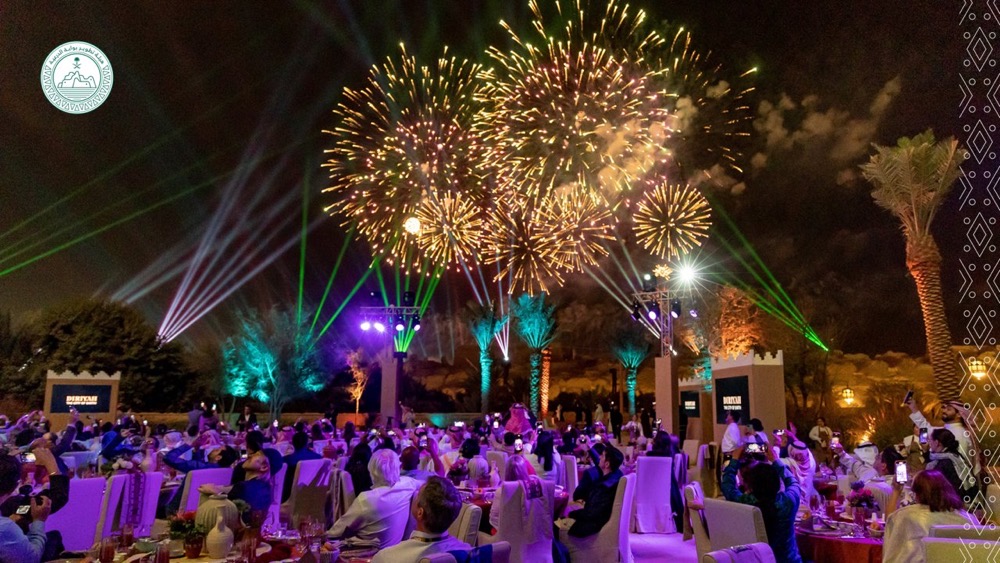
Visitors to the World Travel and Tourism Council Global Summit enjoy a taste of traditional Saudi hospitality in the Kingdom’s birthplace. (DGDA)
At-Turaif and Bujairi Terrace will officially open to the public on Dec. 4, and Inzerello outlined what is next in store.
“After tonight we are going to open up a lot of assets,” he said. “We have the first hotels under construction that will open next year, the first museums that will open next year, we have already planted 6 million trees on our way to 50 million trees, plants and bushes.
“Every year now we will open assets, we will ground-break assets and we will announce assets every year until 2030.”
Diriyah has long been renowned for its hospitality and generosity, its strength and its power — now it opens its gates to the world to give visitors a taste of the past and a glimpse of the future.
